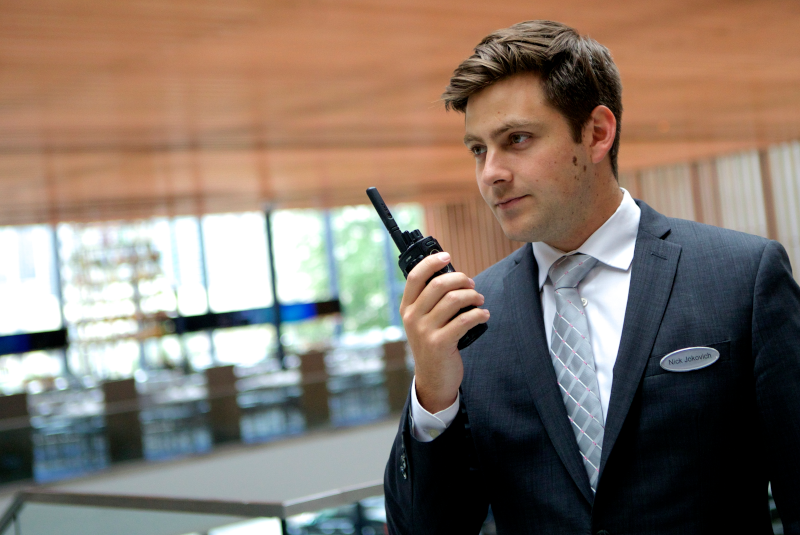Two-way radio frequencies play a key role in the operation of your two-way radios. All two-way radios work on defined radio frequencies that are assigned by the Federal Communications Commission (FCC).
When you are in the market to outfit your operation with two-way radios, it’s important to understand about two-way radio frequencies so you can choose the one that will best meet your businesses specific requirements.
Two-Way Radio Frequencies Golden Rule
Like most things in life, there are a few key principles to know to help you find the right solution, and two-way radio frequencies are no different. Here is the golden rules of two-way radio frequencies:
- The lower the frequency, the farther the distance radio communications can travel.
- The higher the frequency, the better the in-building penetration.
- This means a lower frequency like 150MHz in the VHF radio band will travel farther, and a higher frequency like 450MHz in the UHF radio band will work better inside of buildings.
The great thing to know is that regardless of your industry or application there is a two-way radio frequency that will work well for your Maryland, Washington DC, Pennsylvania, Virginia, or New Jersey business.
VHF Two-Way Radio Frequencies
VHF (very high frequency) is the designation given for radio frequencies that fall between 30MHZ to 300MHz range. The FCC (Federal Communications Commission) has designated that frequencies from 136-174MHZ will be assigned to land mobile radios.
VHF frequencies are well suited for use outdoors where maximum range is required and there are little to no obstructions. Industries that use for VHF radios are:
UHF Two-Way Radio Frequencies
UHF (ultra-high frequency) The FCC has segmented out a couple of frequency bands in the UHF spectrum for land mobile radios:
- 403-430MHZ
- 450-470MHZ
- 450-512MHZ
Most two-way radios in the USA operate in the UHF range. As we discussed earlier UHF radio frequencies are suited for businesses that will be operating indoors, but it is also a great all-purpose frequency for businesses that need to work both inside and outside. Industries that commonly use UHF spectrum for radio systems are:
700MHz Public Safety Frequency Spectrum
The 700 MHz Band consists of 108 megahertz of spectrum running from 698-806 MHz. This gives it excellent propagation characteristics allowing the 700 MHz signals to easily maneuver around buildings and walls.
The D-Block (758-763 MHz / 788-793 MHz) is allocated to public safety for use in a nationwide broadband network. First Responder Network Authority (FirstNet) is an independent authority within the U.S. Department of Commerce that holds the license for both the existing public safety broadband spectrum (763-769 MHz/793-799 MHz) and the D Block. FirstNet is charged with the responsibility of deploying and operating the nationwide public safety broadband network.
Public Safety and Government agencies have also deployed their own 700MHZ radio systems for use in their local, county, state area for coordination with the various public safety agencies that are operating. This added coordination allows for quicker responses, better allocation of resources, and over all unified communications. Here are some of the organizations that use the 700MHZ spectrum:
- Police – Local, State, and Federal departments
- Fire & EMS
- Federal & Local Government Agencies
800MHz Frequency Spectrum
The 800MHz band falls in the 790MHz to 862MHz range. Operating in this band are public safety radio systems like those used by first responders, but most of those have transition to the 700MHZ spectrum in the last 10 years. Also, the 800MHZ frequency spectrum was used by LMR radio wide area system operators and PTT radio platforms like Nextel. In the last 10 years most of the systems operating in this spectrum have moved to allowing the FCC to consider repurposing this spectrum down the road to other technologies.
900MHz Frequency Hopping Digital Spread Spectrum
900 MHz band is a Frequency Hopping Digital Spread Spectrum which uses a method of transmitting radio signals by rapidly switching a carrier among many frequency channels. 900 MHz onsite radios are a license-free technology unique to the Motorola DTR700. The Motorola DTR700 is a great radio option for small operation in warehousing, hotels, healthcare, education & retail.
LTE Systems – Push-to-Talk Over Cellular
In the last couple of year LTE technologies such as Push-to-talk over cellular (PoC) have started to become a great option for business with staff in the field. Motorola released the TLK100 & TLK150 radios, as well as smartphone application to connect with radios in the field. Some of the great advantages of PoC radios and systems are:
- They connect instantly with your team
- User has device options – Portable Radios, Mobile Radio, or Smartphone Application
- Nationwide Coverage
Some of the industries that have found a great advantage with PoC radios are:
- Transportation – Buses, Long Haul Trunking, Waste Removal
- Construction – Cement Trucks, Dump Trucks
- Security – Private security and investigators
- Property Management
CBRS
CBRS (Citizens Broadband Radio Service) operates on the 3.5GHz band (3550MHz to 3700MHz). This previously protected spectrum used by the US Navy and other DoD members has been opened up for shared wireless access. CBRS will drive access to publicly-available broadband spectrum for the first time – providing entry for a wide variety of industrial, and commercial businesses. Organizations can design their own coverage, customize the network, and bring devices online with better capacity and data insights. Some of the industries that have found CBRS systems an advantage are:
Wireless Inc. can help you take care of all of your FCC licensing requirements. Find out which two-way radio system meets your Mid-Atlantic business needs with our Free Motorola Radio Selector Tool.

